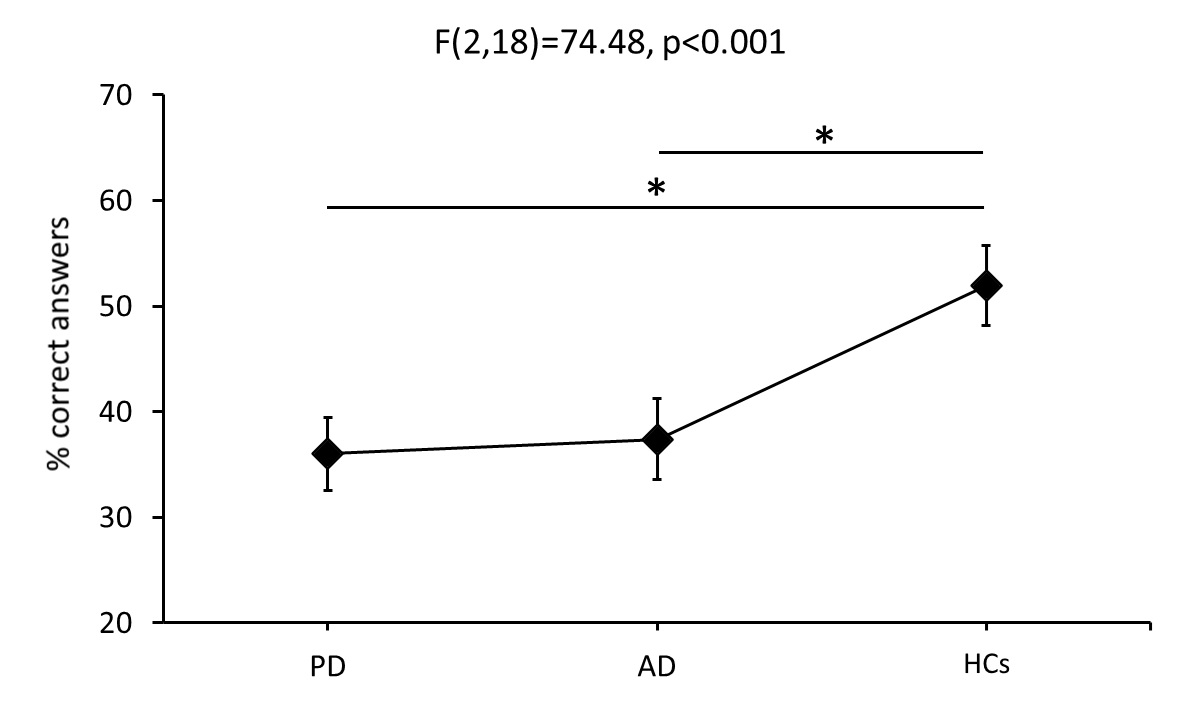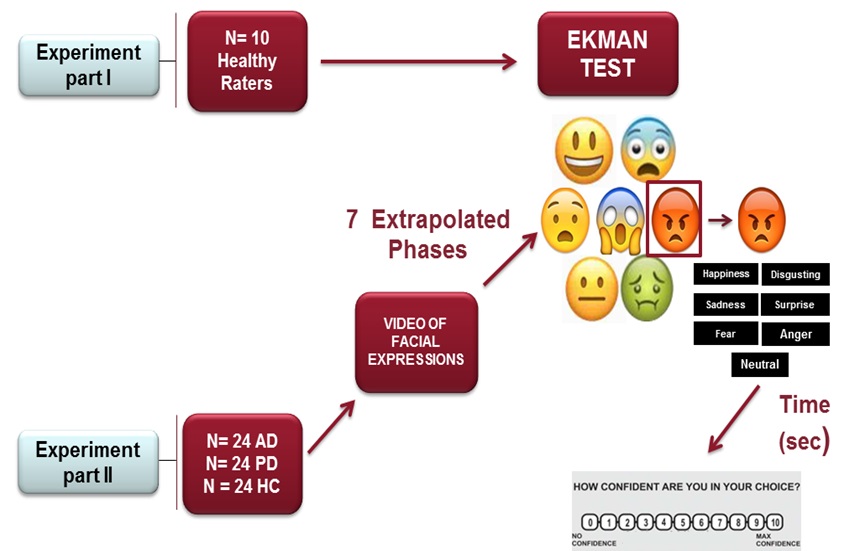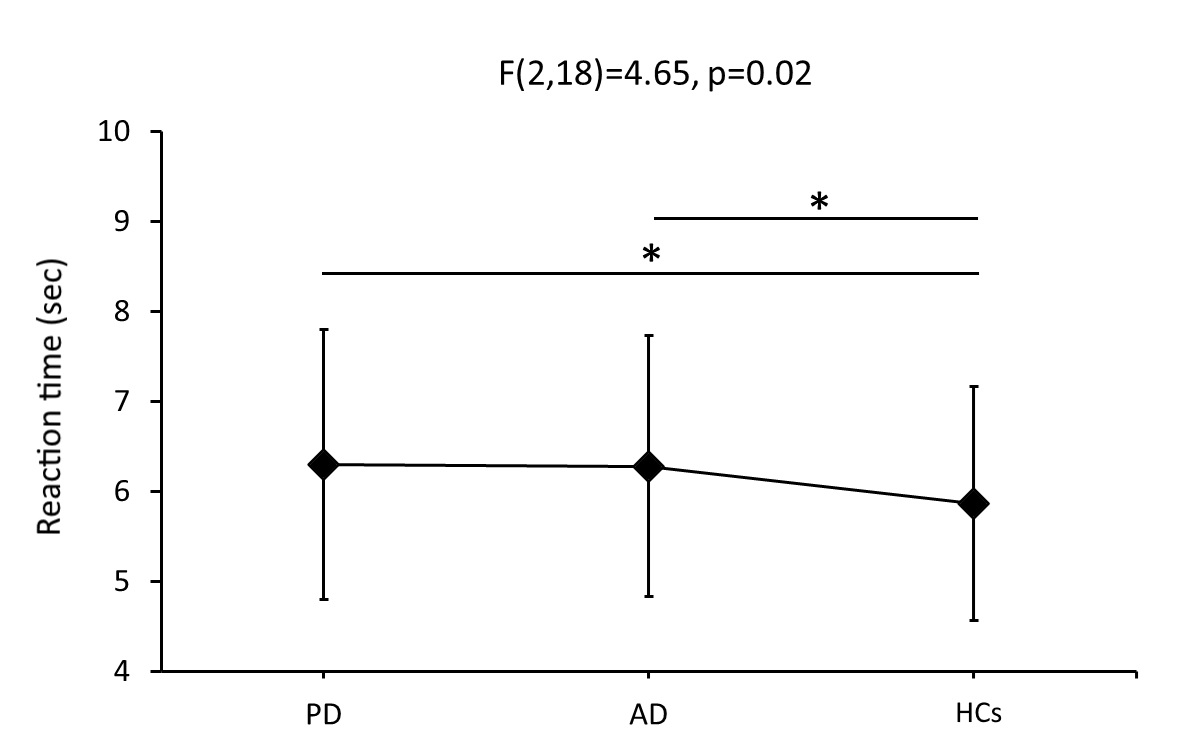Category: Parkinson's Disease: Pathophysiology
Objective: We here aimed to comprehensively investigate facial emotion expressivity in Parkinson’s disease (PD) and Alzheimer’s disease (AD) patients compared to healthy controls (HCs).
Background: Among motor symptoms, one of the most prominent features in PD is reduced facial expressivity, e.g., hypomimia. Although parkinsonian signs and symptoms are relatively common in AD, no study has specifically assessed the possible occurrence of reduced facial expressivity in these patients.
Method: Twenty-four PD patients (17 M, mean age ± standard deviation:73.83±4.2 years), 24 AD patients(9 M, 77.79±7.8 years), and 24 HCs(13 M, 72.96±7.1 years) were video-recorded while posing facial expressions of six primary emotions (anger, disgust, fear, happiness, sadness, surprise) and neutral expressions. Ten neurologists were screened for the ability to recognize facial expressions during an Emotion Recognition Task (ERT) and then asked to identify the emotion of the participants’ pictures in a seven-forced-choice response format (Emotion Expressivity Task-EET). Accuracy of responses, reaction times, and confidence levels in the response were considered in the analysis(Fig.1).
Results: The overall ERT score was higher than 80% (range:72-93%). In the EET, raters identified a lower number of correct responses in PD and in AD than in HCs (37%,36% and 52% respectively, p<0.01) with no differences between PD and AD (p=0.61)(Fig.2). We also found longer reaction times for the evaluation of patients compared to HCs’ pictures(p<0.05).Finally, the pattern of reduced facial emotion expressivity between PD and AD was similar(Fig.3).
Conclusion: Along with the confirmation of reduced facial expressivity in PD, the study provides evidence of a similar motor abnormality in AD. The facial expressivity deficit in PD and AD may result from common pathophysiology or a manifestation of distinct mechanisms. Further studies should better delineate the clinical relevance of reduced facial expressivity in AD.
References: Ricciardi L, Visco-Comandini F, Erro R, Morgante F, Bologna M, Fasano A, Ricciardi D, Edwards MJ, Kilner J. Facial Emotion Recognition and Expression in Parkinson’s Disease: An Emotional Mirror Mechanism? PLoS One. 2017 Jan 9;12(1):e0169110. doi: 10.1371/journal.pone.0169110. PMID: 28068393; PMCID: PMC5221788.
Bologna M, Merola A, Ricciardi L. Behavioral and Emotional Dysfunction in Parkinson’s Disease. Parkinsons Dis. 2019 Jun 18;2019:1749525. doi: 10.1155/2019/1749525. PMID: 31316745; PMCID: PMC6604351.
To cite this abstract in AMA style:
A. Cannavacciuolo, A. Guerra, D. Colella, M. Salzillo, A. de Biase, G. Paparella, M. Canevelli, G. Bruno, A. Berardelli, M. Bologna. FACIAL EMOTION EXPRESSIVITY IN PARKINSON’S AND ALZHEIMER’S DISEASES [abstract]. Mov Disord. 2022; 37 (suppl 2). https://www.mdsabstracts.org/abstract/facial-emotion-expressivity-in-parkinsons-and-alzheimers-diseases/. Accessed April 18, 2025.« Back to 2022 International Congress
MDS Abstracts - https://www.mdsabstracts.org/abstract/facial-emotion-expressivity-in-parkinsons-and-alzheimers-diseases/



